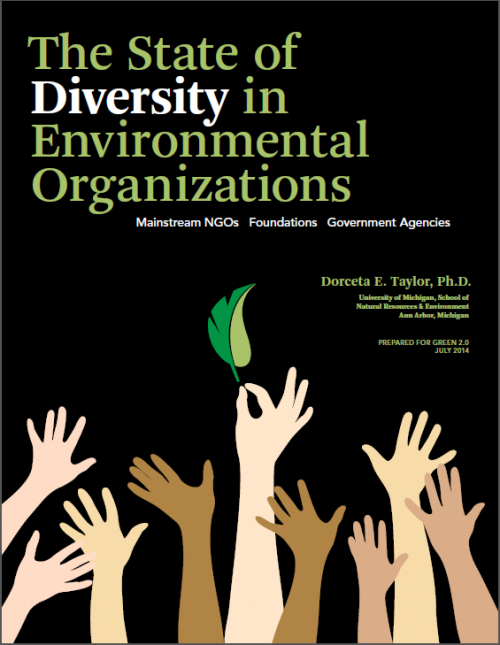
New Report On Why Decades of Promises to Diversity are Falling Short in the Mainstream Environmental Movement
Published onGreen 2.0, an initiative dedicated to increasing racial diversity across mainstream environmental NGOs, foundations and government agencies in the U.S., released the findings of a recent comprehensive report, “The State of Diversity in Environmental Organizations: Mainstream NGOs, Foundations & Government Agencies”. Some key findings include:
1. The Green Ceiling
Despite increasing racial diversity in the United States, the racial composition in environmental organizations and agencies has not broken the 12% to 16% “green ceiling” that has been in place for decades. Moreover, although people of colour support environmental protection at a higher rate than whites, environmental organizations are not adequately reaching out to organizations representing people of colour.
2. Unconscious Bias, Discrimination, and Insular Recruiting
Confidential interviews with environmental professionals and survey data highlight alienation and “unconscious bias” as factors hampering recruitment and retention of talented people of colour. Environmental organizations do not use the existing internship pipelines to effectively recruit people of colour. None of the largest budget organizations had a president, vice president, or assistant/associate director who was a person of colour.
3. Lackluster Effort and Disinterest in Addressing Diversity
Efforts to attract and retain talented people of colour have been lackluster across the environmental movement. Confidential interviews from environmental leaders note that significant and intentional work remains to make the mainstream environmental movement welcoming to people of colour.
The result, the study concludes: “An overwhelmingly white Green Insiders’ Club.”
Ethnic minorities and people of multi-racial backgrounds make up 38% of the U.S. population. However, the study found that people of colour make up less than 16% of environmental NGO general staff. As well, minorities hold only 11.3% of environmental NGO board leadership positions. In top leadership positions, such as board president, the presence of minorities is even more rare. Of the 1,684 board members of conservation and preservation organizations surveyed only 77 or 4.6% were minorities.
Interestingly, Taylor found that very few people of colour are members or volunteers of environmental organizations. While environmental organizations collaborate effectively with each other, few were found to collaborate with minority organizations. And, while environmental organizations expressed a desire to diversify their boards and staff, very few had a diversity committee or diversity manager.
Taylor concluded that, despite this “professed interest in increasing diversity in environmental organizations, there is a gap between the desire to see diversity initiatives developed and actually supporting such activities once they are in place.”
While the current state of racial diversity in environmental organizations remain “troubling”, among the three types of organizations studied, the number one diversity initiative is promoting women. The study found that women now represent more than half of 1,700+ leadership positions of which mostly are white women: 70% of executive directors positions in environmental grant making foundations and only 30% of leadership positions such as presidents and board chairs.
The report provides three specific recommendations:
- “What gets measured gets done.” Make and track diversity commitments and be transparent about progress.
- Be accountable to those commitments, in performance evaluations and grant-making criteria.
- Allocate sufficient resources, including sustainable funding/grants, to ensure that diversity initiatives are successful.
Without these aggressive efforts, Taylor writes, diversity in environmental organizations in “the decade ahead will mirror the last.”
The Canadian context
In their 2012 Diversity Research Report Earth Day Canada (EDC) provided recommendations for environmental organizations to strengthen their capacity to increase diversity in their membership, staff and leadership. They outlined best practices, and also four “best principles” key to engaging diverse communities: relationships, recognition, reciprocity and relevance.
Speaking directly with members of diverse communities, their findings refuted the “myth that diverse communities are not interested or engaged in environmental initiatives.”
In 2012, a study commissioned by DiverseCity: The Greater Toronto Leadership Project, as part of its DiverseCity Counts research series, found that only 15.6% of board positions across NGO sectors are held by visible minorities. Strikingly, this report found that a diversity tipping point exists. When a board reached 30% of diversity in leadership, it reported an increase in benefits.
Both the Canadian and the U.S. case studies share similar recommendations: Environmental organizations need to take real and accountable action to foster diverse participation in all aspects of their organizational structure, including their governance leadership.
As in the United States, environmental organizations in Canada have realized for some time that they need to diversify their membership, staff and leadership. Organizations like the Greenbelt Fund,Sustainability Network, Earth Day Canada, Community Environment Alliance, Toronto and Region Conservation Authority and others have been making improvements in the sector.
In 2014, Earth Day Canada convened a Diversifying Environmental Sector Boards Forum, to explore the benefits of diversifying boards. This winter, DiverseCity onBoard and Earth Day Canada will collaborate again, holding an event for environmental organizations to bring together board-ready diverse candidates and discuss the strategies to improve diverse leadership in the environmental sector. Check back here for more details soon.
Download the Green 2.0 full report, executive summary and highlights here






